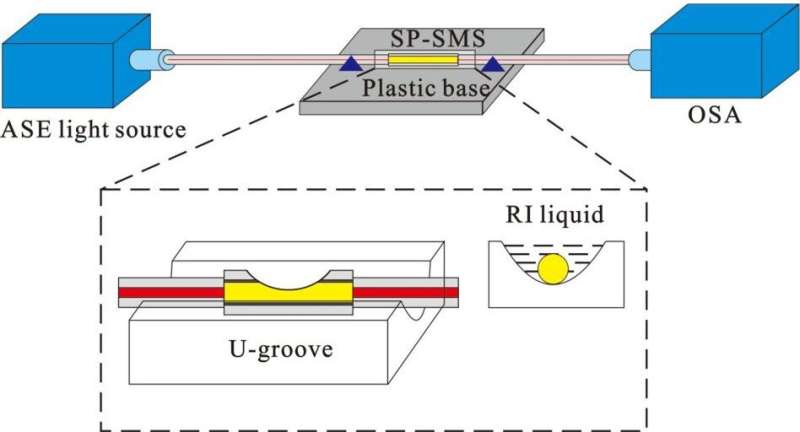Refractive index sensor and measurement system. Credit: Compuscript Ltd
In a new publication from Opto-Electronic Advances, Xuezhi Zhang, Boyue Yang, Junfeng Jiang, Kun Liu, Xiaojun Fan, Zhaozhu Liu, Min Peng, Guanlong Chen and Tiegen Liu from Tianjin University, Tianjin, China discuss a side-polished SMS based RI sensor employing perfluorinated POF.
Refractive index is an inherent property of material, which can reflect the concentration, purity and other important information about a material under certain conditions. When the external refractive index changes, some parameters (amplitude, wavelength, intensity, etc.) in the optical fiber will change accordingly. The change of refractive index can be calculated by the change of the parameters mentioned above. Refractive index sensors are widely used in chemical analysis, environmental pollution monitoring, medical diagnosis, food detection and other fields.
Polymer optical fiber has been used in optical fiber sensing, Internet of things, lighting systems and other fields. Compared with SiO2 optical fiber, polymer optical fiber has many advantages, such as light weight, high flexibility, strong plasticity and so on. In recent years, polymer materials have developed rapidly, and there is great potential to improve the material characteristics and fabrication processes. Some research groups have already begun to study and apply polymer optical fiber. In the field of optical fiber sensing, polymer optical fiber has the potential to replace SiO2 optical fiber in some areas, which has a high value and potential for wide application.
Professor Tiegen Liu's research group has proposed a method to fabricate a refractive index sensor based on perfluoropolymer fiber and single mode—multimode—single mode (SMS) structure, which can realize real-time monitoring of external refractive index by multimode interference. Firstly, perfluoropolymer fiber is sandwiched between two single-mode fibers to generate a multimode interference structure; secondly, the perfluoropolymer fiber is polished to improve the sensitivity of the sensor; finally, the parameters affecting the sensitivity of the sensor are studied experimentally.
In the experiment, the polymer optical fiber and SiO2 optical fiber can easily and accurately be connected by a ceramic sleeve; the fine-tuning system with precision of micrometer scale is included in the side-polished device, which ensures the accuracy in side-polished process of the perfluoropolymer optical fiber. In addition, the perfluoropolymer fiber has low water absorption, which makes the sensor work stably in water for a long time and has obvious application in the field of liquid detection. The results show that the refractive index sensitivity is -219.504 dB / RIU.
In conclusion, the fabrication process of the refractive index sensor is simple and easy, realizing real-time measurement of the refractive index with high sensitivity. This method will provide a reference for future development of refractive index fiber sensing.
More information: Xuezhi Zhang et al, Side-polished SMS based RI sensor employing macro-bending perfluorinated POF, Opto-Electronic Advances (2021). DOI: 10.29026/oea.2021.200041
Provided by Compuscript Ltd
























